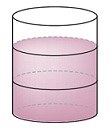Write fractions that represent the shaded and unshaded portions of the figure below
publish date: 2022/10/13 20:19:00 GMT+11

Shaded Fraction = (1)
Unshaded Fraction = (2)
Correct Answer
Explanation
Strategy
We will determine the number of equal parts into which the figure is divided. Then we will determine how many of those parts are shaded.
WHY
The denominator of a fraction shows the number of equal parts in the whole. The numerator shows how many of those parts are being considered.
Solution
Since the figure is divided into 3 equal parts, the denominator of the fraction is 3. Since 2 of those parts are shaded, the numerator is 2, and we say that
\(\frac{2}{3}\) of the figure is shaded. write \(\color{red}{\frac{number of parts shaded}{number of equal parts}}\)
Since 1 of the 3 equal parts of the figure is not shaded, the numerator is 1, and we say that
\(\frac{1}{3}\) of the figure is shaded. write \(\color{red}{\frac{number of parts not shaded}{number of equal parts}}\)
Reference
Mathematics for college students
